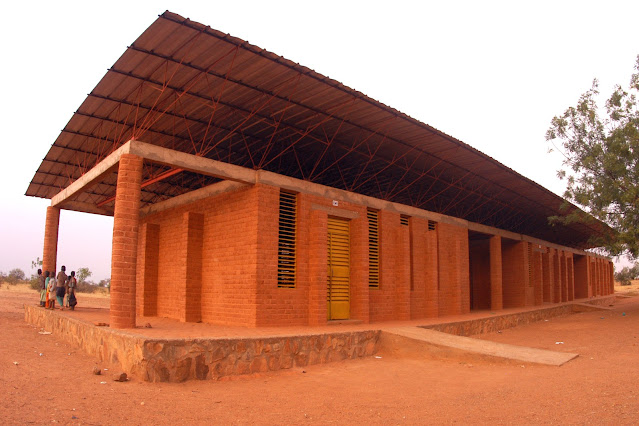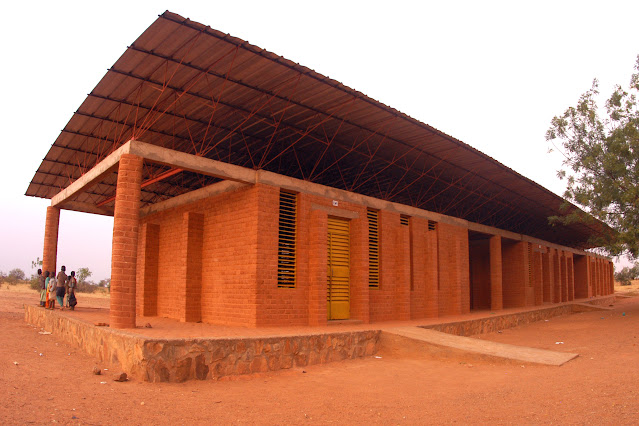 |
| Gando School, Africa |
DESIGN THAT LISTENS TO NATURE: Climate Responsive and Bio-Climatic Approaches in Sustainable Architecture
In a world increasingly impacted by climate change, architects and designers are rediscovering a fundamental principle: the best buildings are those that harmonize with nature. Climate-responsive and bio-climatic design are more than just trendy architectural terms; they are crucial strategies for creating sustainable, comfortable, and energy-efficient spaces that complement the environment rather than oppose it. But what do these concepts really mean, and why are they important in today's world? Let's explore.
OBJECTIVE
In my quest to reach out to the non-technical community for the purpose of awareness on the advocacy behind environmental cause, I would like to emphasize on the importance of the design focusing on the human needs as the priority among all the factors. We need to understand that the response of our design to the nature is just secondary. The main objective is that we respond to the nature in order to meet the needs of the occupants. Let me take this opportunity to thank all of you as you continue reading my blogs, rest assured that the uniqueness of the discussions are based on my acquired education, work experiences, and additional research work to validate authenticity.
What is Climate Responsive or Bio-Climatic Design?
Climate-responsive or bio-climatic design embodies the art of crafting buildings that harmonize with the local climate and environmental conditions. Rather than relying solely on mechanical systems to regulate heat, cold, wind, or rain, these innovative design approaches weave together thoughtful planning, natural elements, and passive techniques to create spaces that are not only naturally comfortable but also remarkably energy-efficient. While some experts draw subtle distinctions between the two terms—viewing "climate-responsive design" as a broader strategy and "bio-climatic design" as a celebration of the synergy between a building and its natural surroundings—most people use them interchangeably. Ultimately, both terms beautifully describe architecture that is attuned to its environment, creating a captivating and sustainable synergy.
Why It Matters in Sustainable Architecture
Buildings that respect their environment offer multiple benefits, making them a cornerstone of sustainable architecture:
✔ Reduced Energy Consumption: By using natural light, ventilation, and insulation, the need for artificial heating, cooling, and lighting drops significantly.
✔ Enhanced Comfort: Occupants enjoy more consistent indoor temperatures, fresh air, and better living conditions.
✔ Lower Carbon Footprint: Less energy use means fewer greenhouse gas emissions, helping to fight climate change.
✔ Respect for Resources: Local materials and designs that suit the climate minimize waste and promote resource efficiency.
Ultimately, climate responsive design is not just about saving energy — it's about creating buildings that are healthier for both people and the planet.
Principles and Strategies of Climate Responsive Design
Here are some of the key ways architects apply these principles:
1. Site and Orientation
A building's position can make all the difference. By carefully orienting the structure to maximize natural light and capture cooling breezes, architects can reduce reliance on artificial systems.
2. Building Form and Layout
The shape and layout of a building matter. For example, compact, well-insulated forms are ideal for colder regions, while open, airy layouts suit warmer climates.
3. Material Selection
Choosing the right materials is crucial. Local, climate-appropriate materials not only reduce environmental impact but often perform better in the given conditions.
In designing and building the Gando Primary School in Africa, Pritzker Price awardee, Architect Francis Kéré’s innovative solution was to use local materials and traditional building techniques to create a school that was not only functional but also sustainable and environmentally friendly.
4. Shading and Sun Control
Overhangs, louvers, pergolas, and even vegetation can be used to block harsh sunlight while still allowing for daylight and ventilation.
5. Natural Ventilation
Designing windows, vents, and openings to encourage cross-ventilation helps maintain indoor air quality and reduce the need for air conditioning.
6. Thermal Mass and Insulation
Using materials like stone, brick, or concrete that absorb and slowly release heat helps stabilize indoor temperatures throughout the day.
7. Rainwater Harvesting and Passive Cooling
Simple techniques like collecting rainwater or incorporating reflective surfaces can help cool buildings and reduce water consumption. Check out our video below:
Climate Zones and Design Responses
Different climates require different design solutions. Here's a quick look at how architecture adapts:
Tropical / Hot-Humid Climates
Lightweight materials
Wide overhangs and shaded verandas
Elevated structures for airflow
Hot-Arid Climates
Thick walls and small windows to block heat
Internal courtyards for cooling
Light-colored exteriors to reflect sunlight
Temperate Climates
Flexible designs for seasonal changes
Good insulation and controlled sun exposure
Cold Climates
Compact building forms to retain heat
South-facing windows (in the Northern Hemisphere) for passive solar gain
High insulation levels
Real-World Examples
Climate responsive design isn’t new — it has been practiced for centuries. Think of:
Traditional Filipino Bahay Kubo: Raised floors, large windows, and thatched roofs keep the house cool in the tropical heat.
Middle Eastern Courtyard Homes: Thick walls and shaded courtyards offer relief in hot-arid climates.
Modern Eco-Resorts and Passive Houses: Contemporary projects that blend traditional wisdom with modern technology to minimize energy use and environmental impact.
Bio-Climatic Design and Modern Technology
Today’s architects don’t have to rely on tradition alone. Smart technologies complement bio-climatic design by enhancing performance:
Solar panels provide renewable energy.
Smart windows adjust shading automatically.
Sensors optimize ventilation and lighting.
The magic happens when modern innovation meets nature-inspired design.
Challenges and Considerations
Of course, climate responsive design isn’t without its challenges:
Some sites have physical or legal limitations.
Budget constraints may affect material choices.
Success depends on integrating these principles early in the design process.
Public awareness and education still need to catch up.
But the long-term benefits — for both the environment and building occupants — far outweigh these hurdles.
FINAL THOUGHTS
Let’s Build with Nature, Not Against It
In the face of pressing environmental challenges, our approach to design and construction must undergo a transformative evolution. Embracing climate-responsive and bioclimatic design opens the door to architecture that transcends mere sustainability—crafting timeless buildings that beautifully harmonize with the land, honor our precious natural resources, and cultivate healthier spaces for all. Now is the moment to create structures that are attuned to the rhythms of nature. When architecture collaborates with the climate, we all thrive.
Interested in learning more about sustainable architecture? Stay tuned for more blogs on design that makes a difference.
Ar J CASTANEDA
Architect, Sustainable Architecture
Link in account for architectural works.
PHOTO ATTRIBUTION
GANDO PRIMARY SCHOOL in Africa
By Helge Fahrnberger / www.helge.at - Own work, CC BY-SA 3.0, https://commons.wikimedia.org/w/index.php?curid=6446608
Bahay Kubo photo is original by Architalktural
Other photos are courtesy of Pexel.com















_April_2016_(26786207140).jpg)
,_Gardens_By_The_Bay_--_2019_--_4468.jpg)






